Volete chiudere più affari? Provate questi modelli intelligenti di e-mail di follow-up per diversi scenari
Ah, la posta elettronica.
Whether you love it or hate it (just kidding, you probably hate it), it’s a necessary evil – especially in the world of sales.
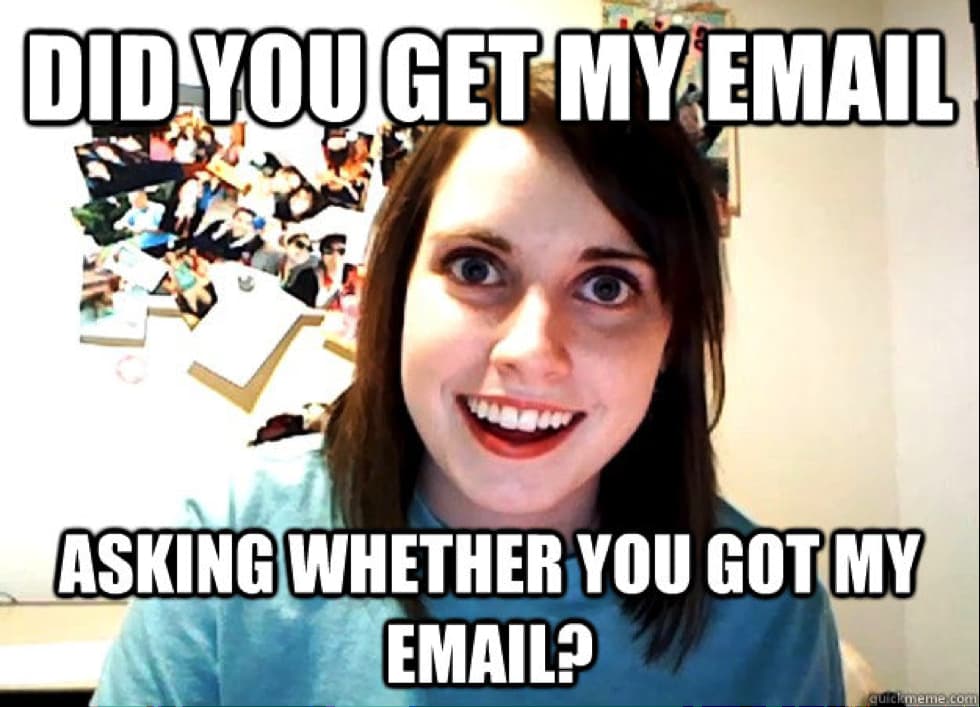
Ma a volte inviare l'e-mail giusta può essere un'impresa. Cosa dire? E soprattutto, come dirlo?
Crafting the perfect email can make or break your sales targets and your relationships with prospects. No pressure! 😅
But don’t fear, you’ve come to the right place.
We’ve put together some excellent email templates for you to use for your follow up! And to make it even better, we’ve categorized the email templates by different scenarios you face on a daily basis as a salesperson. 👍
Quindi, continuate a leggere per trovare il modello giusto per il vostro prossimo messaggio e guardate come arrivano le offerte. Potete utilizzare questi modelli insieme a qualsiasi strumenti di vendita esistenti, content writer e piattaforme di invio di e-mail di massa.
(By the way, if your current bottleneck is getting those first replies, here are the cold email templates that work for us. 💌)
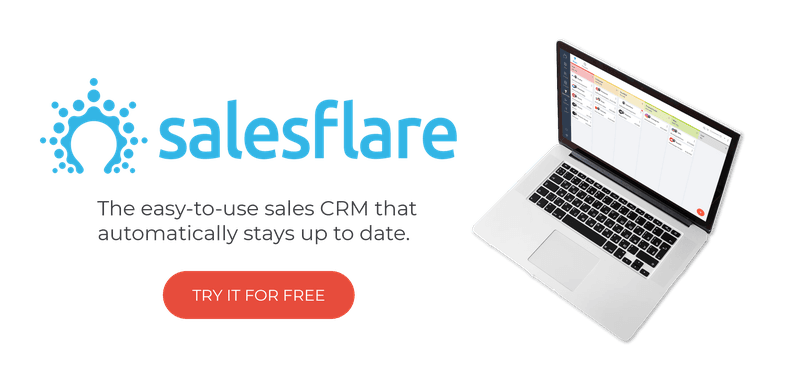
NEW: you can now save and use email templates within Salesflare (even with merge tags!). ✨ Leggi tutto in questo aggiornamento del prodotto.
Scenario 1 – They opened your initial email, but didn’t reply
Situazione
Let’s say you sent a fantastic email to a lead – because of course you did – and they opened it, but then decided to not reply. ☹️
Può essere frustrante sentirsi ignorati, ma rimanete positivi!
Maybe they forgot to respond or the email got lost in the shuffle…or maybe they just aren’t interested or your email went to the wrong person in the company. Until you know for sure, it’s always best to politely follow up.
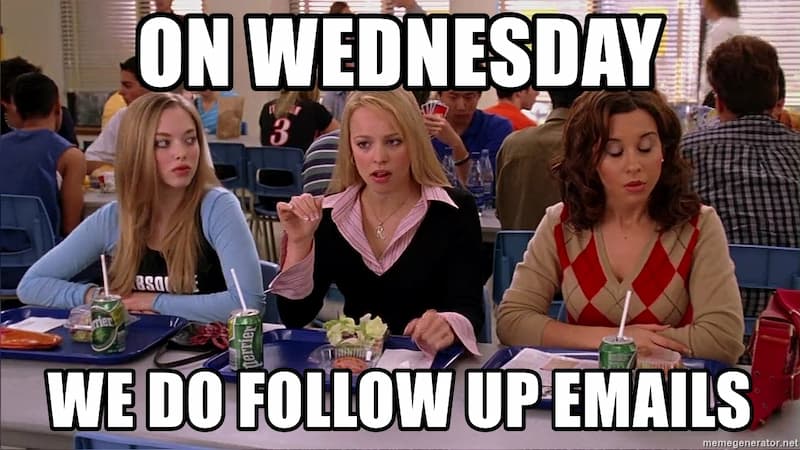
Non preoccupatevi, utilizzate questo modello di e-mail per seguire e cercare di ottenere una risposta da parte loro.
Elementi del messaggio
Assicuratevi di includere:
- Un promemoria sull'ultima e-mail inviata per ricordare loro lo scopo del vostro intervento.
- Una richiesta cortese per una telefonata veloce per sondare l'interesse e comprendere meglio i loro punti dolenti
- Richiesta di parlare con la persona giusta in case the person you’re emailing ends up not being the appropriate person to talk to
Modello di e-mail
Oggetto: Checking in re: [frase veloce che copre l'argomento della tua ultima email]
Ciao [Nome],
I’m writing to follow up on my email regarding [what your last email was about].
I didn’t hear back from anyone on your team. If it makes sense to talk further, let me know how your calendar looks for the next few weeks for a 5-10 minute call.
In caso contrario, chi è la persona più adatta a cui rivolgermi?
Grazie per il vostro aiuto. Non vedo l'ora di sentirvi!
Scenario 2 – You’re referred to someone else within a company
Situazione
Let’s say someone gets back to you – perhaps from using the template in the first category – and they give you the contact details of someone else in the company who would be better suited to speak to.
Great! But now what do you say? 🤔
Elementi del messaggio
Assicuratevi di includere:
- Un collegamento con la persona iniziale avete contattato
- Un punto dolente specifico per l'azienda e come il vostro prodotto o servizio può aiutarli
- Una richiesta di chiamata rapida to discuss your solution further 📞
Modello di e-mail
Oggetto: Ho parlato con [persona che vi ha originariamente indirizzato].
Ciao [Nome],
Ho appena parlato con [la persona che vi ha indirizzato originariamente], che mi ha indirizzato a voi.
Mi sono rivolto a [persona che vi ha indirizzato originariamente] perché ho notato [punto dolente del team e perché è dolente].
[Breve descrizione della vostra soluzione e di come risolve il problema].
Possiamo organizzare una breve telefonata di 5-10 minuti nella prossima settimana per esplorare [soluzione]?
Vi ringraziamo e siamo ansiosi di sentirvi.
✨Tip: Be sure to CC the person you originally spoke to, so that it doesn’t look like a random cold email and gives you more credibility going into the conversation.
Scenario 3 – Someone asked you to follow up later
Situazione
Let’s say you spoke to a prospect, but they said their company wasn’t ready to buy and asked you to come back to them “in a couple months.”
Thankfully, you can set a reminder in Salesflare so that you don’t miss your follow-up email moment (and you’ll have an automated timeline at your fingertips so you don’t forget what you talked about last time). 🤯
Quindi, la vera domanda è: come fare per farli rientrare nella conversazione?
Elementi del messaggio
Assicuratevi di includere:
- Un promemoria di ciò che è stato discusso nella vostra ultima conversazione
- Un'offerta per aiutare a rispondere a qualsiasi domanda persistente
- Una richiesta di parlare di nuovo sulla soluzione
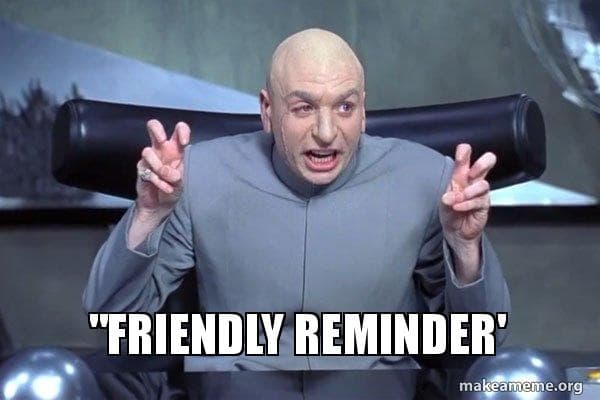
Modello di e-mail
Oggetto: Pronti a continuare la conversazione?
Ciao [Nome],
L'ultima volta che ci siamo sentiti, mi ha chiesto di ricontattarla entro [tempo richiesto] in merito a [argomento trattato l'ultima volta], quindi volevo raggiungerla e darle seguito.
Ha avuto modo di esaminare la mia proposta e di riflettere su quanto abbiamo discusso in precedenza?
I’d be more than happy to do a quick recap of everything on the phone and to answer any pending questions you may have.
Come si presenta il vostro calendario questa settimana per una chiacchierata?
Scenario 4 – Following up after an event
Situazione
You met someone at an event, such as a conference or networking session, or at an office you were visiting, and you’d like to follow up with any business you discussed. 🤝
As it’s a mutual conversation, this should be a relatively easy response to receive – as long as you’re polite and get to the point of your message quickly.
Elementi del messaggio
Assicuratevi di includere:
- Come e dove li avete conosciuti, perché questo li aiuta a ricordare come vi conoscete
- Cosa è stato discusso, per dimostrare di essere interessati a ciò che avevano da dire e di voler continuare la conversazione
- How you’d like to move forward, as this is how you’re able to keep the conversation going
Modello di e-mail
Oggetto: E' stato un piacere incontrarti a [evento/località].
Ciao [Nome],
È stato un piacere incontrarti a [dove li hai incontrati].
Mi è piaciuto molto ascoltare [ciò che è stato discusso].
I think it would be great to chat further about [reason you’re interested in speaking further]. Do you have some time in the next few weeks? Let’s [action: meet for coffee, have lunch, plan a meeting, etc.].
I miei impegni sono aperti il [suggerisci qualche giorno] se va bene anche per te?
Non vedo l'ora di discutere ulteriormente!
Scenario 5 – After a call or meeting
Situazione
You just had a call or meeting with a potential customer – yay! 🎉
But…now what?
Naturally, it’s time to send a follow-up email.
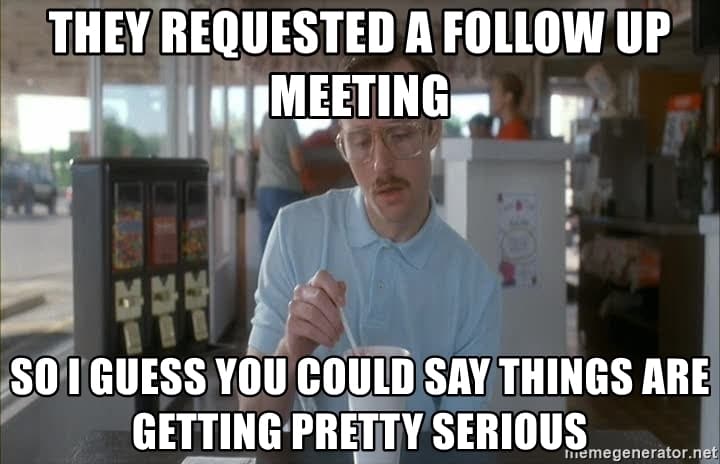
Elementi del messaggio
Assicuratevi di includere:
- Una cortese introduzione dire loro quanto vi è piaciuto parlare con loro
- A reference back to the pain points they’re facing
- Ulteriori informazioni on how your solution can help them (don’t forget any attachments!)
- Un promemoria su eventuali follow-up riunioni o chiamate già fissate
✨Tip: Be sure to schedule a follow-up meeting or call while you’re speaking to them the first time, so that you can keep the conversation going.
Modello di e-mail
Oggetto: Piacere di conoscerti!
Ciao [Nome],
È stato un piacere chiacchierare con lei prima e saperne di più su di lei e sul suo ruolo in [azienda].
I now understand the issues you’re encountering with [a pain point discussed in the meeting] and how it can make it harder to [whatever the pain point prevents them from doing].
As discussed, I’ve attached some more information about our solution and how we can help you with [pain point] and solve [specific business issue].
Please do let me know if you have any questions and I’d be happy to chat again. If not, I look forward to talking again on [predetermined meeting day/time].
Scenario 6 – After a trigger
Situazione
Let’s say you notice on Salesflare that someone keeps visiting your website or a specific product page. 🧐
Maybe they’re interested in what to offer, and just need an extra push.

Note that this template can be adapted for just about any trigger event – such as downloading a whitepaper from your website or a specific promotional email that is opened multiple times. 📬
Elementi del messaggio
Assicuratevi di includere:
- Il prodotto o la pagina specifica in modo da poter rinfrescare rapidamente la memoria di ciò che è stato visualizzato.
- Un suggerimento diretto per una chiamata di follow-up – requesting a low commitment call of 5-10 minutes offers them a chance to learn more and gives you the chance to understand what they’re looking for (and whether your product or service is right for them)
Modello di e-mail
Oggetto: Dimostrato interesse per [Prodotto specifico o pagina del vostro sito].
Ciao [Nome],
Ho notato che questa settimana alcune persone del vostro team hanno esaminato la nostra pagina [Nome specifico del prodotto/pagina], che riguarda/copre/dettaglia [Descrivere la pagina e la funzione del prodotto].
Avete 5-10 minuti per discutere le soluzioni che voi e il vostro team state esplorando? Se sì, come si presenta il vostro calendario questa settimana?
Fate attenzione!
Scenario 7 – Sending a cold email to a prospect
Situazione
As I’ve mentioned in a previous blog, try to warm up to contacting prospects directly before sending them an email.
Some suggestions for warming up to an email: commenting on something interesting they post on LinkedIn, retweeting something they’ve tweeted, etc.
Be sure to do this in a thoughtful and strategic way. But surely, as a salesperson, you already know this. 😉
You’re trying to build a relationship with these companies, so approach it in the same way you would want to be approached — in a more organic, thoughtful way. 💛
Elementi del messaggio
Assicuratevi di includere:
- Una breve presentazione di voi stessi e della vostra azienda
- Un motivo preciso per raggiungere il cliente e uno scopo chiaro per il vostro messaggio
- Una richiesta di approfondimento nonché la richiesta di parlare con uno dei loro colleghi se non sono la persona giusta con cui parlare.
Modello di e-mail
Oggetto: Felice di aiutare con [Soluzione]
Ciao [Nome],
My name is [Your name] and I’m part of the business development efforts with [Your company]. [Quick one-to-two-sentence pitch that explains what your company does].
In base al suo profilo [Canale: LinkedIn, Twitter, ecc.], lei sembra essere la persona adatta con cui entrare in contatto per quanto riguarda [Soluzione].
I’d like to talk to someone from [Their company] who is responsible for [Department/role of people who would use your solution].
If you’re who I should speak to about this, are you open to a 5-10 minute call this week, such as [suggest a few dates/times], to discuss the ways [Your solution] can specifically help your business?
Se non siete voi, potreste mettermi in contatto con la persona giusta?
Vi ringrazio e sono ansioso di sentirvi!
✨Tip: Add a testimonial link to your signature, as it gives you more credibility and social proof to those you email (and you can track whether or not they’ve clicked it!). It’s also a good idea to add a link to your LinkedIn profile so that they can easily answer the question, “Who is this person?”
Sending hundreds of emails can sometimes feel a bit daunting, but hopefully this guide can take a bit of the pressure off! 😁
Plus, many of your email processes can be automated – if you’d like to learn more about following up with automation, check out this handy guide.
Happy emailing! 📧
Volete iniziare a utilizzare questi modelli?
Avere dei modelli è ottimo, ma copiarli in continuazione da un file centrale nelle vostre e-mail non lo è altrettanto.
That’s why we, at Salesflare (yup, this is our blog, and we offer an easy and automated CRM to SMBs selling B2B), have built a cool feature that allows you to:
- salvare questi modelli
- condivideteli con il vostro team
- and use them straight from Gmail or from Salesflare’s CRM itself
L'inserimento di un modello richiede solo un secondo!
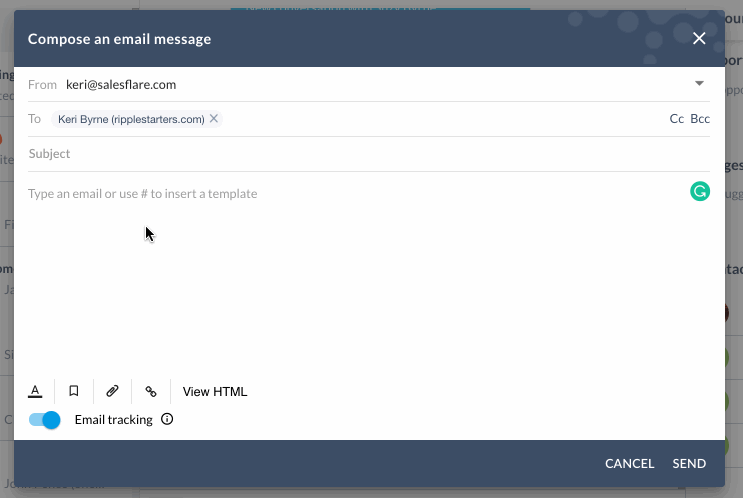
Or, if you’re finding yourself using these templates over and over again to follow up with a list of people, you can take your automation even further and set up sequences of emails with Salesflare’s email workflows.
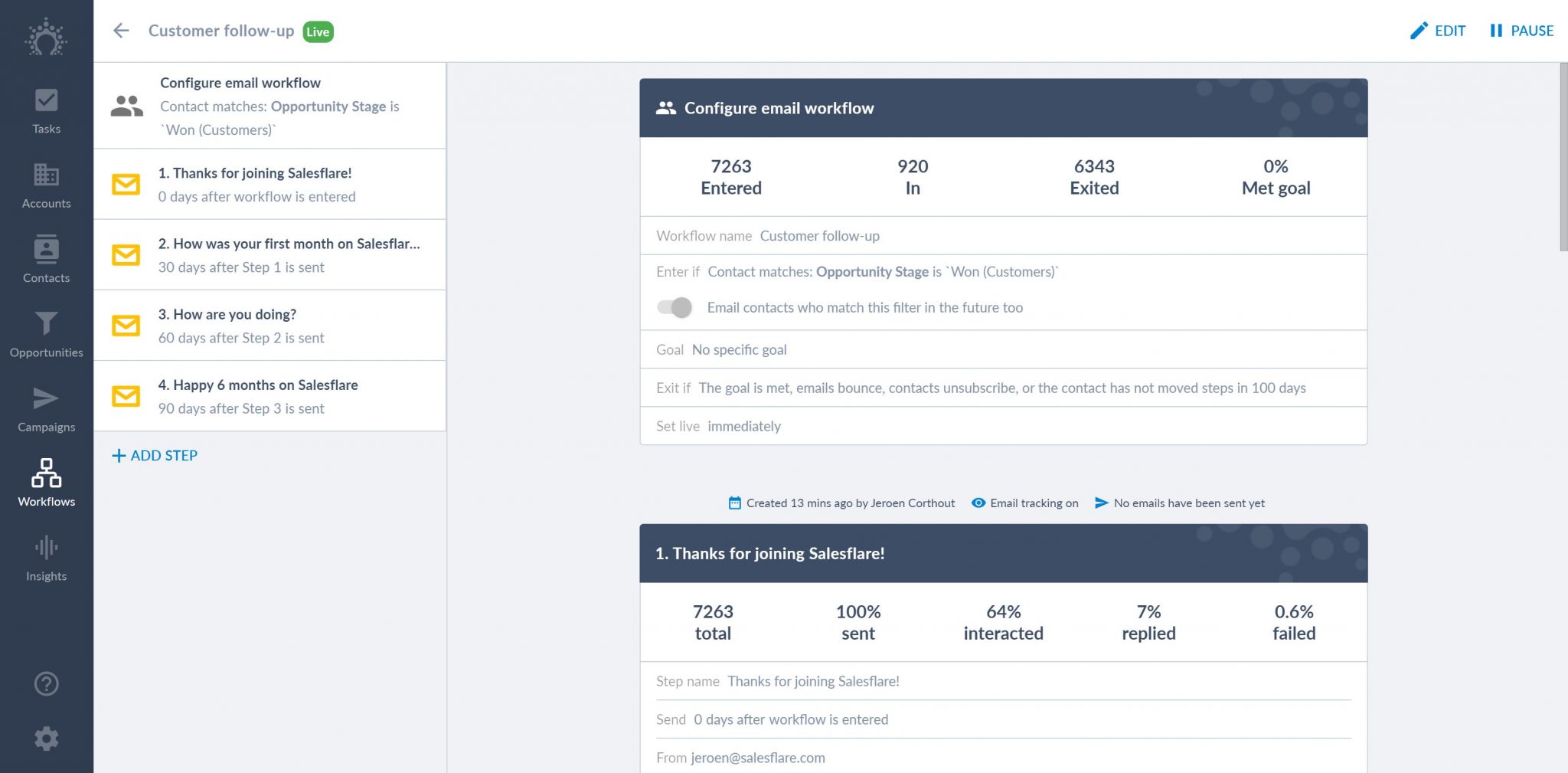
Inviate ai potenziali clienti sequenze di e-mail automatiche e personalizzate che continuino a essere inviate finché non rispondono (o cliccano o aprono la vostra e-mail) e sembri che le abbiate inviate voi stessi, manualmente. Ecco alcuni flussi di lavoro per le e-mail a freddo che ci fanno ottenere ottimi risultati.
Ottenete analisi accurate su tasso di apertura, tasso di clic, tasso di risposta e altro ancora. Impostate obiettivi sui flussi di lavoro, automatizzate la sequenza di e-mail e lasciate che i numeri si calcolino da soli!

You can even see which emails work best and which ones don’t reach your goals, so you can go back and improve to get even better results.
The email automation in Salesflare is powerful. If you don’t trust me, provate voi stessi o guardate alcuni dei nostri clienti che mostrano i loro flussi di lavoro via e-mail prima.
- 22+ Best Sales Podcasts You Should Check Out in 2024 - 21 Dicembre 2023
- Scritture di chiamata a freddo per esseri umani reali - 21 settembre 2023
- Gli oltre 25 migliori strumenti di vendita per aiutare il vostro team ad avere successo - 10 Agosto 2023
